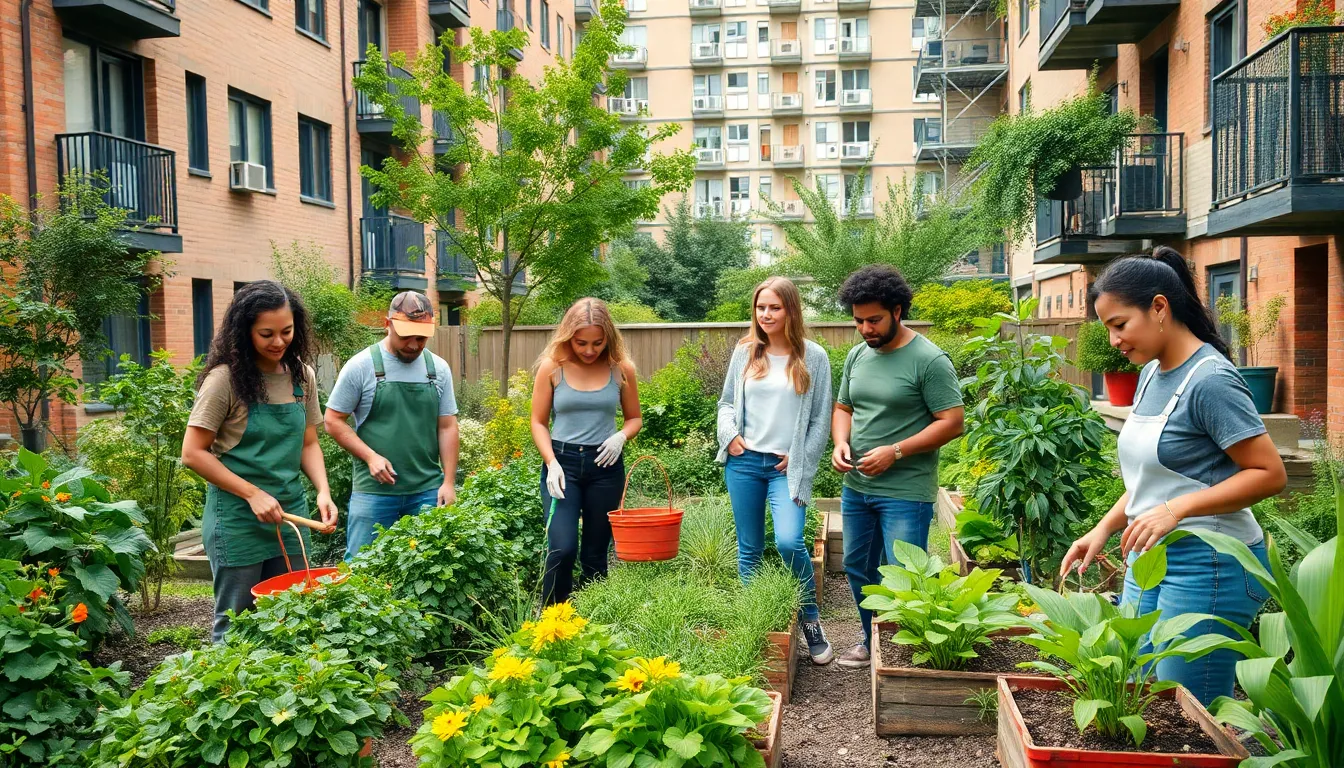In a world where eco-friendly choices often feel like a distant dream, sustainable apartment living is here to save the day—one recycled bottle at a time. Imagine a lifestyle where you can sip your morning coffee guilt-free, knowing that your home is as green as your favorite leafy plant. It’s not just a trend; it’s a movement that transforms how we think about urban living.
Sustainable apartment living isn’t just for tree-huggers or eco-warriors; it’s for anyone who wants to enjoy life while being kind to the planet. From energy-efficient appliances to composting bins that double as conversation starters, this lifestyle proves that going green can be both practical and fun. So buckle up and get ready to discover how to make your apartment a beacon of sustainability without sacrificing style or comfort.
Table of Contents
ToggleUnderstanding Sustainable Apartment Living
Sustainable apartment living integrates eco-friendly practices into urban lifestyles. This approach improves environmental impact while enhancing quality of life.
Definition and Importance
Sustainable apartment living refers to making conscious choices that minimize ecological footprints. It encompasses energy conservation, waste reduction, and resource optimization. This lifestyle resonates with many city dwellers seeking to make a positive difference. Adopting sustainable practices fosters a healthier environment, reduces utility costs, and promotes social responsibility. Living sustainably exemplifies a commitment to future generations, ensuring they inherit a healthier planet.
Key Principles of Sustainability
Key principles of sustainability in apartment living include energy efficiency, water conservation, and waste management. Energy efficiency emphasizes using appliances that consume less energy, such as LED bulbs and Energy Star-rated devices. Water conservation encourages practices like low-flow fixtures and rainwater harvesting systems. Waste management focuses on recycling materials and composting organic waste to reduce landfill contributions. Incorporating these principles not only conserves resources but also creates comfortable and stylish living spaces. Fostering a community mindset enhances engagement and cooperation among residents.
Benefits of Sustainable Apartment Living

Sustainable apartment living offers numerous advantages. These benefits extend beyond just individual lifestyles to positively impact communities and the environment.
Environmental Impact
Sustainable apartments significantly reduce carbon footprints. Energy-efficient appliances and smart technologies lower energy consumption, leading to decreased greenhouse gas emissions. Water-saving fixtures enhance conservation efforts as well, ensuring the responsible use of this precious resource. Community gardens promote biodiversity by encouraging native species and providing habitats for local wildlife. Residents actively participating in recycling programs further minimize waste sent to landfills. Such actions contribute to cleaner air and improved ecosystem health, fostering a more sustainable urban environment.
Economic Advantages
Living sustainably leads to substantial cost savings. Reduced utility bills result from energy-efficient technologies and renewable energy sources. Many sustainable apartments incorporate materials that lower maintenance costs and enhance durability. Tax incentives and rebates may be available for residents who choose green upgrades, translating into further savings. Investing in energy-efficient systems can yield higher property values for owners as eco-friendly features become increasingly desirable. Such financial benefits make sustainable living not just an ethical choice but also a smart economic decision.
Tips for Sustainable Apartment Living
Sustainable apartment living involves making intentional choices that benefit both individuals and the environment. By implementing simple strategies, residents can significantly reduce their ecological footprints.
Energy Efficiency Practices
Energy-efficient appliances play a crucial role in reducing energy consumption. Selecting ENERGY STAR certified devices ensures optimal performance while using less electricity. Additionally, adopting LED light bulbs decreases energy usage and longevity. Using smart power strips eliminates energy waste from devices in standby mode. Regular maintenance of HVAC systems keeps them running efficiently. Lastly, utilizing natural light maximizes sunlight during the day, reducing reliance on artificial lighting.
Water Conservation Techniques
Water-saving fixtures are essential for sustainable living. Installing low-flow showerheads significantly reduces water usage without sacrificing comfort. Dual-flush toilets and faucet aerators also contribute to lower consumption. Moreover, fixing leaks promptly prevents water waste and conserves resources. Collecting rainwater for outdoor watering allows residents to utilize natural resources effectively. Finally, being mindful of water usage during everyday activities promotes a culture of conservation within the community.
Sustainable Apartment Features
Sustainable apartment features enhance both comfort and eco-friendliness. They create spaces that promote energy efficiency and resource conservation.
Eco-Friendly Materials
Natural materials play a crucial role in sustainable apartments. Bamboo flooring offers durability while being rapidly renewable. Recycling materials, like reclaimed wood for cabinetry, reduces waste and adds character. Low-VOC paints create healthier indoor air, minimizing emissions and chemical exposure. Energy-efficient insulation options, such as straw bales or cellulose, also improve thermal performance. Sustainable countertops, made from recycled glass or paper, provide stylish yet functional surfaces. These choices embody a commitment to environmental stewardship within living spaces.
Green Amenities
Green amenities contribute significantly to sustainable living. Rooftop gardens offer urban dwellers access to fresh greenery and promote biodiversity. Community composting stations reduce waste while fostering a sense of community among residents. Fitness centers equipped with energy-generating machines not only promote wellness but also harness energy from workouts. Rainwater harvesting systems enable efficient water use for landscaping. Additionally, electric vehicle charging stations encourage eco-conscious transportation. Access to shared bicycles promotes sustainable commuting options while reducing reliance on cars. Together, these amenities support a lifestyle centered around sustainability.
Community and Social Aspects
Sustainable apartment living thrives on strong community ties and collective action among residents. Engaging with neighbors fosters a spirit of cooperation and accountability, leading to a more robust and eco-friendly environment.
Building a Sustainable Community
Creating a sustainable community necessitates collaboration among residents. Shared resources, such as community gardens or tool libraries, enhance connections while promoting eco-friendly practices. Participating in neighborhood events raises awareness about sustainability initiatives, enabling individuals to learn from each other’s experiences. Building a sense of trust encourages residents to contribute ideas that benefit their shared space, creating an involvement loop that enhances the communal living experience. Community-led initiatives, like composting programs, allow residents to take ownership of their environmental impact.
Encouraging Sustainable Practices Among Residents
Encouraging sustainable practices among residents shapes a greener living space. Hosting workshops on energy efficiency empowers residents with knowledge and practical skills. Organizing clean-up days not only beautifies the surroundings but also emphasizes the importance of maintaining a clean environment. Incentives, like rewards for participating in recycling programs, can motivate residents to adopt eco-friendly habits. Fostering a culture of sustainability inspires individuals to implement green practices in their daily routines, contributing to the overall health and vitality of the community. Communication channels, such as newsletters or online forums, facilitate sharing tips and successes, making sustainability a shared goal.
Sustainable apartment living represents a transformative approach to urban life that combines eco-conscious choices with modern comforts. By adopting green practices and utilizing sustainable features, residents can significantly reduce their environmental impact while enjoying a stylish and comfortable home.
This lifestyle not only fosters individual well-being but also strengthens community ties, encouraging collaboration and shared responsibility among neighbors. As more people embrace these principles, the movement toward sustainable living continues to grow, paving the way for healthier environments and vibrant communities. Every small step taken in the pursuit of sustainability contributes to a larger goal, making a positive difference for future generations.


